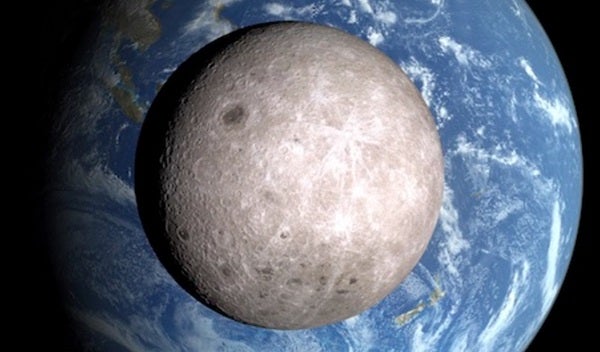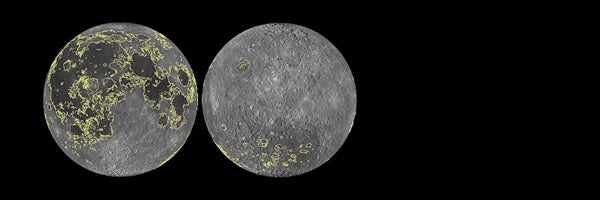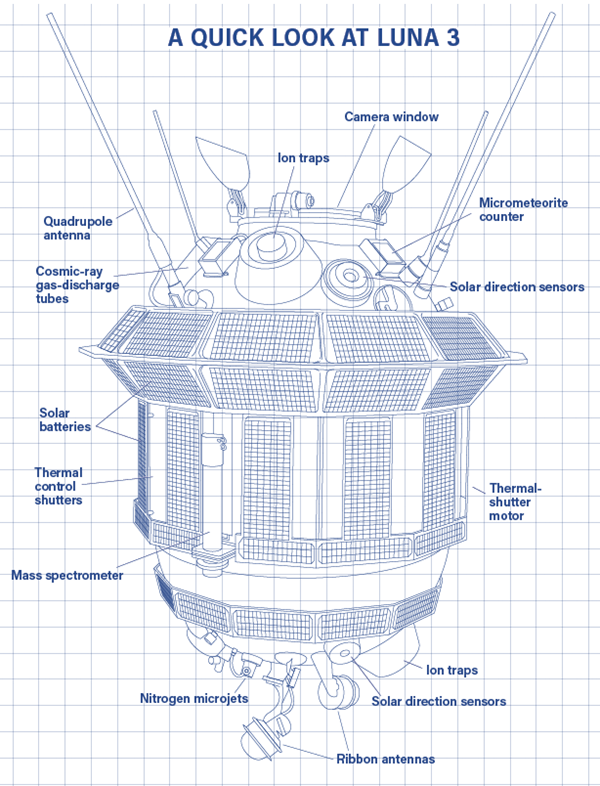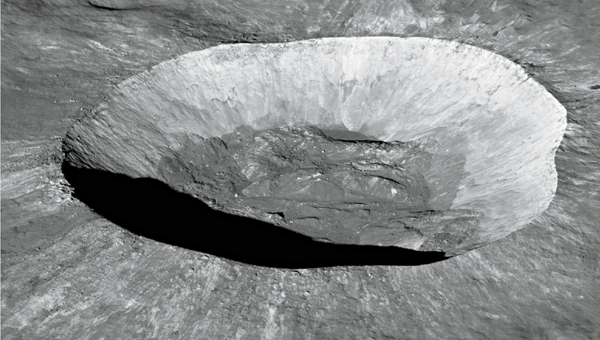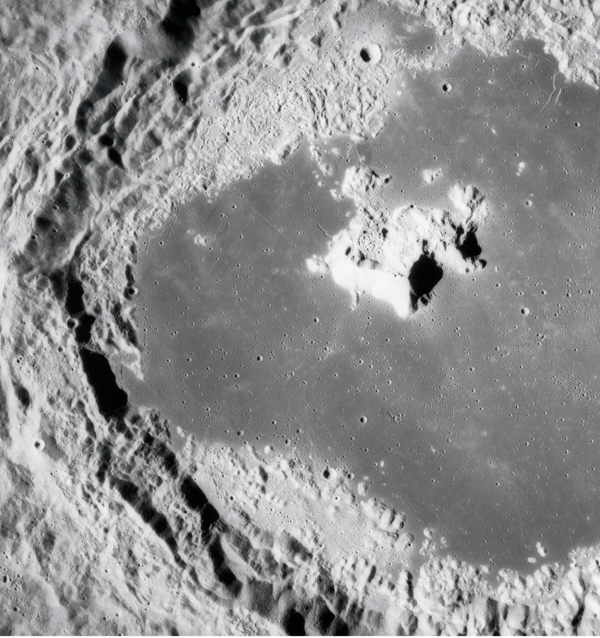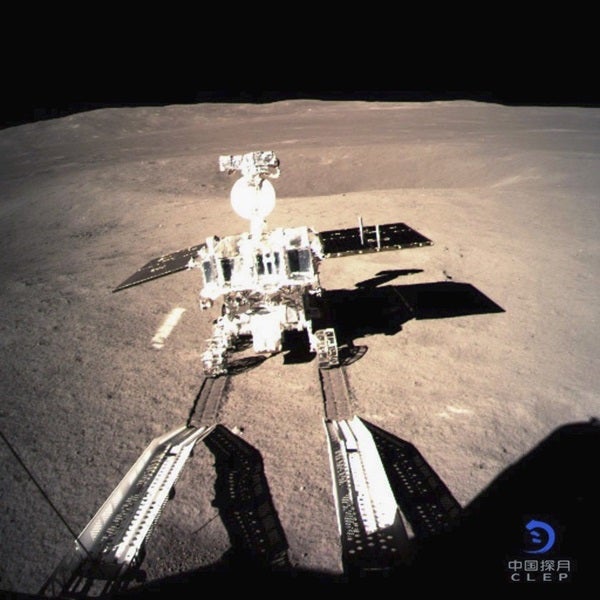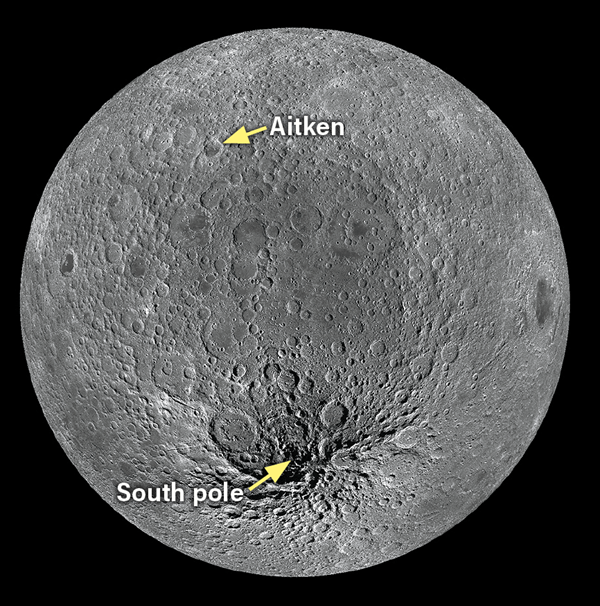Sometimes erroneously referred to as “the dark side” (a byword for lunacy made famous by the rock band Pink Floyd), this alternate face of the Moon arises from its synchronous relationship with Earth. The Moon circles our planet every 27.3 days, precisely in lockstep with the time it takes to revolve upon its own axis. Consequently, each lunar day equals a lunar year, and the effect is that we only ever see the same half of the Moon.
But that’s not the whole story. A tilt in the Moon’s orbit and orientation with respect to the plane of the solar system — the ecliptic — produces a monthly north-south “wobble.” As it moves farthest from the ecliptic, an additional 6.5° of latitude beyond its northern and southern poles briefly becomes visible. Similarly, after passing its closest and most distant points from Earth, an east-west rocking of its orbit reveals 8° of extra longitude at its eastern and western extremities. These so-called librations offer occasional glimpses of the farside: from the age-worn Pasteur Crater in the east to the mountainous rings of Montes Rook and Montes Cordillera, which encircle the Mare Orientale impact basin like a gigantic bull’s-eye in the west.
Accounting for the effects of libration, 59 percent of the lunar disk can be seen from Earth at certain times. And until six decades ago, the rest remained blank, a nightly reminder of the limits of human knowledge. By default, the Moon’s farside was thought to closely mirror the Earth-facing nearside: 70 percent primordial highlands and 30 percent younger maria, or “seas” of long-cooled lava. These seas witnessed eons of meteoroid bombardment, which pulverized rocks into powdery regolith and fractured the lunar crust to such immense depths that basalt magmas inside flushed to the surface, spewing iron-darkened deposits onto thin-floored craters.
Then, on October 7, 1959, Luna 3 flew over the partly lit farside, shattering the illusion of homogeneity between the Moon’s two hemispheres.
Revealing a two-faced Moon
As the name implies, Luna 3 was the third Soviet space probe sent to the vicinity of the Moon. But Luna 3’s voyage was a troubled one. Teams of exhausted engineers — holed up in tents, trailers, and rickety barracks at tracking stations in Crimea and Kamchatka — spent days battling electronic glitches and telemetry dropouts. In fact, Luna 3’s goal of photographing the farside was so audacious that the Soviets avoided mentioning it in their official communiqué to the world.
The Luna 3 probe carried 40 square frames of temperature-resistant, radiation-hardened film tucked inside a lead-lined cartridge. Ironically, the film originated from the U.S.’s Genetrix high-altitude reconnaissance balloons, which were captured over Soviet airspace in the late 1950s. To snap pictures, Luna 3 rotated itself to align one axis to the Sun, then used a photocell to detect the Moon before sending a command to open its dual-lens camera doors, much like a pair of great mechanized eyelids.
The Soviets could not bring the Genetrix squares back to Earth, however, so the film was developed, fixed, and dried aboard the spacecraft. Then, after onboard equipment scanned and converted the intensity of moonlight into an electric signal, it was sent line by line via slow-scan television across nearly 300,000 miles (482,000 km) of space. Luna 3’s immense distance and feeble signal initially yielded only static. Then, a blotchy monochrome disk emerged onto thermal-paper printouts at Soviet listening posts. Twenty-nine images were eventually transmitted to Earth, and with them, a formerly unknown land suddenly became known.
But the greatest surprise was the lack of maria. Only 2 percent of the farside is covered by these ancient lava deposits, compared to 31.2 percent of the nearside. One Life magazine journalist labeled the farside “more monotonous than the known front face,” while the chairman of the Astronomical Council at the Soviet Academy of Sciences admitted it was “an exciting problem.” By chance, the public release of Luna 3’s images coincided with a live screening of the BBC’s The Sky at Night program, whose host, Patrick Moore — despite his usual penchant for rapid diction — found himself momentarily at a loss for words.
What happened to create these two quite dissimilar lunar faces? Current thinking postulates that a Mars-sized impactor, named Theia, hit Earth in a glancing blow around 4.5 billion years ago (see “The Moon’s violent origin,” in the November 2019 issue). This impact displaced huge amounts of material that eventually coalesced to form the Moon in a synchronously locked orbit. As its Earth-facing nearside broiled for millions of years under the extreme heat radiated by our infant planet, the farside cooled, and a temperature gradient steadily evolved between the two lunar hemispheres.
The rare farside maria Luna 3 did spot include Mare Ingenii (Sea of Ingenuity) and a handful of dark craters: Thomson, whose rim was severely worn by ancient lava; the rough-floored O’Day; and the figure-eight-shaped Van de Graaff, which exhibits puzzling groovelike textures along its perimeter. Ingenii sits directly opposite Mare Imbrium and was created by a Jamaica-sized impactor 3.8 billion years ago. Scientists think that powerful seismic waves produced during the event converged on the Moon’s farside, producing tremors, landslides, and furrowed topography. The Apollo 15 astronauts saw light-colored swirls along Ingenii’s southern rim, which NASA’s Lunar Reconnaissance Orbiter (LRO) confirmed lie neither higher nor lower than the surrounding environs. They probably represent remnant magnetism in the crust, which prevents the solar wind from fully weathering the surface. In some spots, localized magnetic fields prevent charged solar wind particles from striking the lunar surface. So, areas that are magnetically shielded remain relatively bright, while unprotected soil darkens over time.
The crater first became a historical curiosity one summer evening in 1178, when five Canterbury monks watched the Moon spew flame and writhe “like a wounded snake” before turning black. Some scientists, including geologist Jack B. Hartung, theorized that the monks might have witnessed Giordano Bruno’s birth. And indeed, the crater’s bright rim and highly reflective rays — which meander for around 180 miles (290 km) — indicate that it is very young.
But not that young. If an impactor had gouged Giordano Bruno within the last millennium, it would have thrown 10 million tons of debris into space and precipitated a week-long meteor storm on Earth. No historical records for any such event exist.
Besides, the chance of an impact by a city-block-sized object in the last few centuries ranks at about 0.1 percent. In 2008, Japan’s Selenological and Engineering Explorer mission showed through crater-count analysis that Giordano Bruno is about 4 million years old. It seems more plausible that the Canterbury monks were simply in the right place at the right time to see a minor impact at about the same location.
Apollo eyes the farside
In the deep south of the Moon’s farside, Luna 3 picked out a crater so spectacular that Apollo astronauts would later use it to gain their bearings over this intractable gray land. Over 100 miles (160 km) wide, it was named for Soviet rocket pioneer Konstantin Tsiolkovsky. It’s not the biggest crater on the Moon, but its high-terraced walls sweeping down to its dark mare floor, as well as its astounding W-shaped central peak, make it instantly recognizable. Tsiolkovsky clearly affects many craters in its surrounding area, too — intruding into age-worn Fermi, connecting via a sinuous gully to Waterman, trailing secondary impacts like a chain of pearls towards Mendeleev, and spattering the inner walls of Neujmin.
Flying over the lunar farside on Apollo 15, astronaut Al Worden spotted Tsiolkovsky’s central peak rising high above the lunar limb, long before its well-defined rim came into view. Although Worden had scrutinized photographs from NASA’s Lunar Orbiter missions, they did scant justice to the multitude of textures visible within the giant crater. From an altitude of 10 miles (16 km), Tsiolkovsky filled Worden’s window, revealing maria concentrations in its southern and eastern corners, and skyscraper-sized boulders littering its floor. Whatever object created Tsiolkovsky, Worden mused, must have hit the Moon like a pebble in a pond, causing the unique central peak to rebound from the lunar interior. It reminded Worden of “a Swiss alp, a towering pale slab of rock,” while Apollo 16’s Mattingly described it more whimsically as “a marshmallow float[ing]” atop hot chocolate.
It is unsurprising that Tsiolkovsky took precedence on scientists’ wish lists of sites to explore, and geologist astronaut Jack Schmitt actively lobbied to land an Apollo crew there. But with no Earth visible in the sky, such a mission would require two satellites placed 30,000 miles (48,300 km) over the farside to route communications back home (as China’s Queqiao relay does for the Chang’e-4 probe). “Out of sight, out of mind,” Schmitt’s colleagues joked about the possibility of undertaking such an audacious expedition, but their jests underlined the growing sense of unease following Apollo 13’s near disaster. Flight Director Gene Kranz hoped that astronauts “living by courage and ingenuity alone” on the farside, like descendants of Byrd and Peary, Scott and Cook, might reignite the interest of a fickle public and NASA alike. Sadly, it was not to be.
The only naked-eye farside explorers to date are the 24 Apollo astronauts who circled the Moon between 1968 and 1972. And rather than spending their first pass gawking at a rare view of the farside, they spent their time concentrating on getting themselves safely into lunar orbit. NASA trajectory planners had determined, to the split second, when the astronauts would disappear and reemerge from behind the Moon, where they would lose and then reestablish radio contact. But Frank Borman of Apollo 8 could not believe the accuracy of their predicted numbers. When the voice of Mission Control went dead exactly when the astronauts were told it would, a surreal silence pervaded the spacecraft. Borman turned to his crew and wondered, with only a half-smile, if the flight director had intentionally turned off the radio.
For those astronauts left alone in lunar orbit, the farside afforded spectacular isolation while the crew was cut off from Earth for 48 minutes during every two-hour passage around the Moon. “I am alone now, truly alone, and absolutely isolated from any known life. I am it,” wrote Apollo 11’s Mike Collins. “If a count were taken, the score would be 3 billion, plus two over on the other side of the Moon, and one-plus-God-knows-what on this side.” Collins had seen lonely places on Earth while flying jets over Greenland in the dead of winter, so he felt no appreciable anxiety. But Apollo 14’s Stu Roosa noticed the isolation when the air inside the spacecraft turned clammy and he intuitively felt the darkness all around him while his fellow Apollo 14 crewmates, Alan Shepard and Edgar Mitchell, were on the lunar surface.
Of course, the term “dark side” is misleading, for the Moon’s unseen face receives equal sunlight and shadow to the nearside. But when it truly was dark, with no sunlight or earthshine, it reminded Collins of being alone on a skiff in the Pacific, on a pitch-black night, with only the stars and the unlit ocean for company. Worden and Mattingly savored the solitude of the farside. And for Roosa, heading back around the nearside into the rising Sun brought a sense of renewal and rebirth.
The Moon’s colossal crater
Three-quarters of the farside was visible to Luna 3, but its gravelly photographs also indicated another landmark: the goliath South Pole-Aitken Basin, which runs from the great terraced crater Aitken all the way southward to the pole. Measuring 1,600 miles (2,600 km) wide and twice as deep as Mount Everest is tall, the dark-floored basin is the Moon’s largest and oldest impact feature. From our backyards, we can just barely discern its rim in the form of the forbidding Leibnitz Mountains. The Lunar Orbiters and Apollo astronauts were the first to measure its gargantuan dimensions.
More recently, the Clementine, Lunar Prospector, and Galileo probes registered high levels of iron, titanium, and thorium in the great basin. This prompted suggestions that the basin may contain iron-rich crustal elements, large swathes of impact-melted material, or, indeed, traces of the lunar mantle itself, excavated from the deep interior. Since the mantle offers insights into how the Moon formed, directly sampling it is highly desirable.
And it was at the South Pole-Aitken Basin, within a dark-floored crater named Von Kármán in January 2019, that China’s Chang’e-4 probe became the first spacecraft to land safely on the lunar farside. Four months later, results published in the journal Nature indicated the presence of minerals that seemingly fit the geochemical profile for the mantle. They were probably excavated by the impact that forged the crater Finsen, to the northeast of Von Kármán. And this exciting preliminary discovery kindles the possibility of sending sample-return missions to the lunar farside.
For the more distant future, the Moon’s once-unseen face offers great promise. When humans next return to our nearest celestial neighbor, they could do worse than choose a collapsed lava tube in Mare Ingenii for their habitat, suitably protected underground against solar and cosmic radiation. It would make sense to situate powerful telescopes in large farside craters — like Daedalus or Saha — with no electrical interference from Earth and perfectly clear skies without the slightest wisp of atmosphere to distort observations. These lunar scopes might even allow us to tune in to signals from E.T., explore for water ice, or dig up helium-3 to help solve the world’s endemic fossil-fuel dependency.
Sixty years after Luna 3’s visit, the farside is considerably less “dark,” having been subjected to the instruments of robotic explorers, the eyes of astronauts, and the probing of Chang’e-4. It has been extensively mapped, photographed, and described down to resolutions of just a few hundred feet. And although enormous technical and engineering challenges still lie ahead before we can claim the lunar farside as our off-planet home, one thing is certain: Against many odds, in October 1959, Luna 3 — the little robot that could — voyaged to an uncharted place, finally making an unknown world known.

